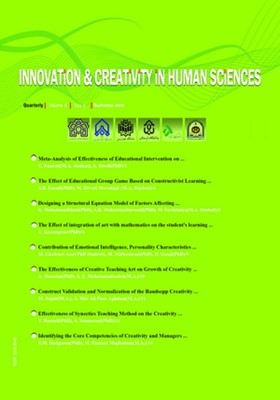Construct Validation and Normalisation of The Raudsepp Creativity Questionnaire among High School Students
Subject Areas : Creativity and innovation from psychological, epistemological, educational and pedagogicalMohaddeseh Nejati 1 , asghar shir alli pour 2 *
1 - university of jahrom
2 - teacher- educational
Keywords: Constract Validation, normalisation, Raudsepp Creativity Scale,
Abstract :
Background: Creativity is such a multidimensional, complex and fuzzy concept that its definitions and indicators are vague and inaccurate Purpose: Constract Validation and Normalisation of The Raudsepp Creativity Questionnaire. Method: Correlation study on a sample of all third grade students of Marand high schools with a sample size of 393 (136 boys and 257 girls) whom were selected through multistage cluster sampling. Research instruments comprised Raudsepp creativity questionnaire and American Creativity Association scale.Results: The results of exploratory factor analysis found out three factors of “sensitivity”, “idea development” and “self-confidence”. In addition, the analysis shows that these three factors explain for 61.30% of the creativity variance. Confirmatory factor analysis showed that the extracted agents can measure creativity to a desirable level. Reliability, convergent validity and diagnostic analyses on creativity factors demonstrate that the questions are accurate enough in measuring creativity. As Cronbach's alpha test results in higher than 0.60 reliability and higher than 0.70 combined reliability, all three agents possess appropriate levels of accuracy. Standardised T and Z normalisation scores show that pupils who score more than average on T scalesenjoy good levelsof creativity, while those with less than average T scores do not have good levels of creativity. The present study shows that the questionnaire is highly reliable, valid and appropriate for creativity measurement.Conclusion: The Raudsepp scale can be utilised in pedagogy and psychology.
البرزی، محبوبه؛ رضویه، اصغر. (1390). تأثیر انگیزش بیرونی بر خلاقیت کودکان، تازه های علم شناختی، شماره 2 ، 52-66.
احمدی، ابراهیم. (1393). خلاقیت و ناراستگویی: توانایی توجیه رفتار غیر اخلاقی، روانشناسی تحولی، شماره 41، 31-41.
حسینی، افضل السادات.(1386 ). بررسی تأثیر برنامه آموزش خلاقیت معلمان بر خلاقیت، پیشرفت تحصیلی و خود پنداره دانش آموزان، فصل نامه نوآوری های آموزشی، شماره 23 ، 147-168 .
راجرز .(1378). ماهیت خلاقیت و شیوه های پرورش آن، ترجمه: افضل السادات حسینی، مشهد: آستان قدس رضوی.
سیف هاشمی، فخرالسادات.(1382 ).بررسی رابطه بین ذهنیت فلسفی و میزان خلاقیت مدیران متوسطه شهر اصفهان در سال تحصیلی 82-1381، فصلنامه تعلیم و تربیت، شماره 77 ،31-64.
شیولسون، ریجارد.(1384). استدلال آماری در علوم رفتاری. جلددوم، قسمت اول.ترجمه: علیرضاکیامنش،تهران:انتشارات جهاد دانشگاهی.
شیرعلی پور، اصغر؛ فرزاد، ولی اله؛ حسین نژاد، غلامرضا و اسدی، مسعود. (1393). مدل ساختاری نقش خلاقیت، ذهنیت فلسفی، خودکار آمدی و خود پنداره ریاضی بر پیشرفت ریاضی. ابتکار و خلاقیت در علوم انسانی، دوره 3، شماره 4، صفحه 55-78.
شجری، فتحالله.(1378). یادگیری خلاق، چاپ دوم، انتشارات انجمن قلم ایران.
عزیززاده، سهیلا. (1386). اثر بخشی آموزش خلاقیت بر افزایش نگرش کارآفرینانه بیکاران شهر تهران، پایاننامه کارشناسی ارشد، دانشکده روانشناسی و علوم تربیتی علامه طباطبائی.
قاسمزاده، حسن. (1379). آینده خلاقیت و خلاقیت آینده. تهران: انتشارات ناهید، چاپ اول.
قاسمی، فرشید؛ اقلیدس، طاهره .(1384). بررسی تأثیر آموزش درس پرورش خلاقیت در کودکان به افزایش خلاقیت دانش آموزان دختر سال دوم کودکیاری هنرستانهای شیراز، فصلنامه نوآوری های آموزشی، شماره 13 ، ص 58-84.
کلاین،پل(1380). راهنمای اسان تحلیل عاملی. مترجم: سید جلال صدرالسادات، اصغر مینائی. تهران: انتشارات سمت.
میرکمالی، سید محمد .(1380). تفکر خلاق و باروری آن در سازمان های آموزشی، مجله روان شناسی و علوم تربیتی، شماره دوم، 103-107.
مهدوی نژاد، غلام حسین؛ مهدوی نژاد، محمد جواد و سیلوایه،سونیا. (1392). تاثیر محیط خلاقیت هنری بر خلاقیت دانش اموزان، نوآوری های آموزشی، شماره 48، 127-140.
نوروزی، رضا علی؛ درخشنده، نگین .(1386). بررسی اثرات کار فلسفی با کودکان از دید گاه دانشآموزان مدارس ابتدائی شهر اصفهان، فصل نامه نو آوری های آموزشی، شماره 23 ، 123-145.
ناصری، حشمت .(1377). بررسی رابطه بین عزت نفس، خلاقیت، جایگاه مهار و خود یابی با عملکرد تحصیلی دانش آموزان پسر سال دوم نظام جدید شهرستان مسجد سلیمان، پایان نامه کارشناسی ارشد، شورای تحقیقات ادراره کل آموزش وپرورش استان خوزستان.
مسدد، علی اصغر .(1369). هنر و علم خلاقیت، شیراز: مرکز نشر دانشگاه شیراز.
هومن،حیدر علی.(1384). تحلیل داده های چند متغیری در پژوهش رفتاری، تهران: پیک فرهنگ.
Donald, F.W., Donald, T.J. (1971). Self- concept, divergent thinking ability, and attitudes about creativity and problem solving. American Research Association. 5, 554-561.
Fleith, S. D., Renzulli, k. l., (2002). Effects of creativity training program on divergent thinking abilities and self- concept in monolingual and bilingual classrooms. Greativity research journal. 14, 373-386.
Fornell. C., Larcker. D., (1981). Evaluating structural models with unobservable variables and measurement error, Journal of marketing research, vol. 18, NO.1, 39-50.
Golman, D., Kaufman, p.v., & Ray, m. (1992). The creative spirit. Dutton: N.Y.
Good,T.L.,& Brophy, J.E.(1990). Educational psychology: a reali stic approach.london. long man.
Guilford, C., Arthur, J.(2001). Greativity in education and learning: AGuide for teachers and educators.69-94 london: kegan paw.
Lawshe. C. H. (1975). A quantitive approach to content validity. Pfronnel psychology. 28, 563-578.
Raudsepp, E. (1999). Creative Growth Games. New York: Putnam.
Rinderman, H. Neubauer, A.C. (2004). Processing speed, intelligencs, creativityand school perfor mance: Testing of causal hypotheses using structural eguation models. Intelligence V32.N573-589.
Rouhollahi, V. Rozan, M. Mehrotra, A. (2014). Assessing the Creativity and Its Obstacles based on theIndividual Characteristics. Sociological Research. 5(1).
Şenol, B. Aksu, A. (2015). Creativity and Sense of Humor of Elementary School Principals. Mevlana International Journal of Education (MIJE). 5(1). 189-205.
Winstone, E., & Others. (1985). the relationship between achievement, self- consept, creativity, and teacher expectations among native children in a northern Manitoba school. Alberta journal of educational Research v30n3p213-25.

